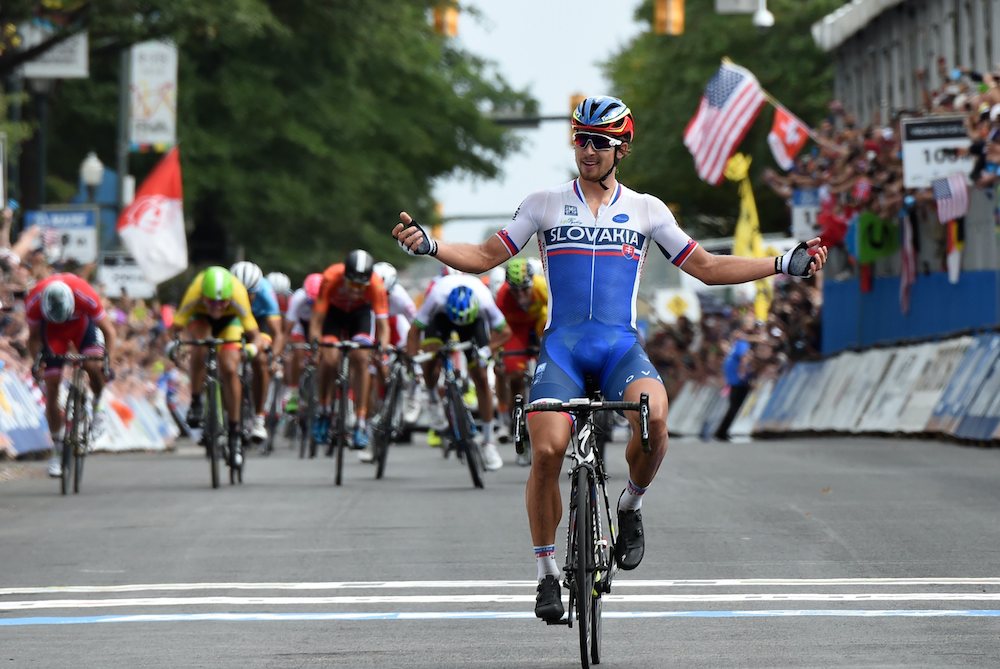Peter Sagan: How the World Championships was won
Peter Sagan's perfectly-timed move in Richmond to net him the world title dispelled the myth once and for all that he has power but lacks tactical nous

Peter Sagan attacks in the 2015 Mens World Road Championships
He may already have won multiple grand tour stages, semi-classics and the Tour de France green jersey for four successive years, but there was a feeling yesterday that Peter Sagan has finally delivered on his enormous potential.
Over the last couple of years, the Slovak’s name has become more synonymous with finishing second and third and missing out on big wins rather than - as at the start of his career - his extraordinary talents.
>>> The nine defining moments of Peter Sagan’s 2015 season (videos)
This season, especially, had only served to reinforce that somewhat unfair reputation. Despite more breathtaking performances to win several more WorldTour stages and the overall at the Tour of California, the moments that linger in fans’ memories - and, if his tweets are anything to go by, Oleg Tinkov’s - are the near misses; him again failing to land a Tour de France stage, falling short in the spring classics, and gesticulating at the motorbike that forced him to abandon the Vuelta.
But that all changes now he is world champion. Any doubts that he lacked the nous or the stamina for the longer and more prestigious one-day races were dispelled in one explosive, brilliantly-timed attack, and he’ll now spend all of the 2016 season in the rainbow stripes - a visual reminder that, whatever happens next season, he has now won one of the most sought-after prizes in cycling.

To do so, he rode the perfect race in very difficult circumstances. Unlike most races where he often has the might of his trade team Tinkoff-Saxo to support him, here his Slovakian team was limited to just two domestiques (his brother Juraj Sagan and Michal Kolar), meaning he did not have riders he could put at the front of the peloton to chase and cover breaks, and making him vulnerable should any misfortune in the shape of a mechanical come his way.
>>> Peter Sagan storms to World Championship road race victory in Richmond
The latest race content, interviews, features, reviews and expert buying guides, direct to your inbox!
Consequently, Sagan kept a low profile. Often he is criticised for being too visible and trying to ride too much on the front foot - even during his much-praised run of getting himself into the break in consecutive days at the Tour de France, none of those moves culminated in a stage victory. But yesterday he camouflaged himself in the peloton, biding his time and waiting for his moment.
Contrast his performance with John Degenkolb’s. He was considered by many to be the pre-race favourite, and rode like one, putting his German team at the front of the bunch to chase moves, and then following them himself in the final lap. Though he reached the top of Libby Hill right at the front of the race, the effort ultimately proved to be too draining, and he faded out of contention on the final two climbs.
Sagan is often criticised for tactical naivety, but yesterday he made his move at precisely the right time. At the bottom of 23rd Street (the penultimate climb) he suddenly moved to the front of the race with an attack no-one could respond to. Belgium’s Greg van Avermaet tried to follow his wheel, but, perhaps suffering the consequences of having chased the previous move on Libby Hill, slipped inexorably away, leaving Sagan alone out front with the finish in sight.
Even then he was still conscious of preserving energy, gaining his speed from his exaggeratedly aerodynamic position on the subsequent brief descent rather than wasting any precious resources pedalling. The gap he gained turned out to be big enough, and one last huge effort up the final climb and on the finishing straight saw him hold off the field by three seconds for victory.
https://www.youtube.com/watch?v=zoCvceSbTn0
Was Sagan the strongest rider in the race? He was undoubtedly one of the strongest, but Van Avermaet’s two sustained moves and the power of Zdenek Stybar’s attack on Libby hill suggested they both had the legs to win. But timing is crucial in cycling, and whereas they had nothing left for the finale, Sagan, like multiple world champions before him, wisely used up his efforts for maximum reward.
Even the decision to make an attack rather sit back and wait for the sprint was a bold one that paid off handsomely. His run of second and third places at the Tour often came from finishing behind faster sprinters, and the odds would have been against him in a bunch finish against the likes of Alexander Kristoff and Michael Matthews (who ultimately won the sprint for second). By going out on the attack he opted for an all or nothing approach, rather than hedging his bets on another likely runners-up finish, and was rewarded with the ultimate prize.
It’s easy to forget just how young Sagan still is - aged just 25, he would have been the youngest world champion since 2005 were it not for Michal Kwiatkowski’s victory last year. He still has many years ahead of him, and can finally move on safe in the knowledge that he will always be a world champion.
Stephen Puddicombe is a freelance journalist for Cycling Weekly, who regularly contributes to our World Tour racing coverage with race reports, news stories, interviews and features. Outside of cycling, he also enjoys writing about film and TV - but you won't find much of that content embedded into his CW articles.